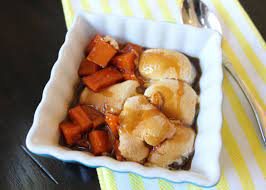Regular white potatoes and sweet potatoes belong to different plant families. You can bake them both whole, but sweet potatoes’ best result will be different from regular ‘tater. Sweet potato lovers want crispy skin and soft flesh. This is surprising considering that baked Russet potatoes are light and fluffy.
I tried a few popular recipes and one of my own to find the perfect sweet spot for baked sweet potatoes. Some people prefer a slow, slow roast at low heat. Some cooks prefer different methods… you’ll need to continue reading to find out. The easiest method may end up being the best.
A few notes about methodology
Sweet potato preparation: All sweet potatoes were roughly equal in weight, weighing between 8 1/2 to 9 1/2 ounces each. To remove excess moisture, they were scrubbed and dried. To cover sweet potatoes with olive oil, I used about 1 teaspoon.
Test for doneness: Sweet potatoes were cooked until a knife was inserted in the center of each potato, and it glided through without resistance.
Ratings The flavor and texture were the key indicators of success. Crispy skin and a soft and tender interior are the two most important characteristics. I also looked at the time to bake the sweet potatoes to determine if a longer cooking time was worth it.
Baked Sweet Potato Method: Halve Before Baking
A whole sweet potato can take about an hour to bake in the oven. Would cutting it in half reduce the time needed for baking? This was my hypothesis. However, it was proved wrong.
I cut the sweet potato in half, wrapped it in foil, and baked it at 400°F for 1 hour 10 minutes.
Because the foil held the moisture and steamed the potato, the skin didn’t turn crispy. The potato flesh was firm and starchy. This method is not efficient and results in a poor texture. It can also be dangerous to slice a thick, raw sweet potato in a straight line. This can lead to injury.
Baked sweet potato method: Add oil
It is common to recommend temperatures between 375F and 425F for roasting vegetables. I decided to split the difference and use 400F. I tried several methods to bake the sweet potatoes at this temperature. I first poked each sweet potato a few times with a fork to let any excess steam escape. Then, I cooked them the following:
- Baked unwrapped and plain on a foil-lined baking tray
- Wrapped in foil
- After rinsing with olive oil, wrap in foil
- After being rubbed with olive oil, bake unwrapped on foil-lined baking sheets.
All these methods produced sweet potatoes cooked through in approximately one hour. However, they each had an imperfect result.
I prefer the unwrapped, olive oil-rubbed sweet potato out of all the options. Although it had dry skin, it wasn’t super crispy. However, it was starchy on the inside. It wasn’t soft or sweet enough to be truly extraordinary.
Foil-wrapped potatoes were more tender inside than unwrapped ones, but the skins had been steamed rather than crisp. If I were pureeing the flesh of the sweet potato, I would wrap it in foil and roast it.
Baked sweet potato method: Bake at low temperature, then broil.
Following her instructions, I poked the sweet potato with a fork. Then, I placed it on foil-lined baking sheets and baked it at 275F for 2 1/2 hours. The sweet potato turned out very soft after the slow, low bake. However, I didn’t get as much caramelization as she said. Following her instructions, I placed the sweet potato under the broiler until it was crispy and charred on the top. It took 6 minutes to cook using my regular-issue broiler.
Broiling was essential to get crispy skin. The flesh was delicious, but it was worth waiting 2 1/2 hours for the potato to cook. You can plan if you can.
Baked Sweet Potato Method: Freeze First
This is one of the most interesting ways to bake sweet potatoes I have ever seen. It involves freezing sweet potatoes solidly then baking them at low temperatures before applying high heat. This method is said to bring out sweet potatoes’ sweetness better than any other. This is the logic: Excess water is removed from the potato by freezing sweet potatoes. Also gives the sweet potato more time to convert starches into sugars due to the low temperature at the start of baking.
After putting the sweet potato in the freezer for a night, I wrapped it in foil and placed it on a foil-lined baking tray. After baking it for two hours at 300°F, I carefully removed the foil. I finished the sweet potato by raising the oven temperature to 350°F and roasting it for 40 minutes until the skin was browned and spots were charred.
It worked, and it was surprising to me. The potato inside was even softer than when it was slow-cooked. The skin was crispy, with a few burnt spots.
Even though the cooking time is roughly the same and there’s an extra step of freezing sweet potatoes, I preferred this method to the slow-and-slow. Both will make a great baked sweet potato. However, both require you to jump through some hoops. Can you make sweet potato perfection without putting in as much effort? This is what I set out to prove with the following method.
Baked Potato Method: Rub the potatoes with oil, then roast at high temperature
After trying all of the methods, I finally decided to combine two factors: oiling the sweet potatoes and baking them at a higher heat.
I used the same method as the 400degF method. I poked the sweet potato with a fork then rubbed them in olive oil. Finally, I roasted the potatoes unwrapped on an aluminum foil-lined baking tray at 450degF. Even though the potatoes took longer to cook at higher temperatures, the results were much better.
This is the best method: Crispy skin, but not burned, and a soft, melting interior are the results. The skin was crisp but not too burned, and the flesh had the same soft caramelization levels as low-and-slow or frozen-roasted methods without cooking for a long time.
This is the best option for those who don’t have the time or memory to store a sweet potato in the fridge or cannot wait until dinner is ready.






More Stories
Chocolate self saucing pudding
Chicken patties recipe
Can you eat a raw potato